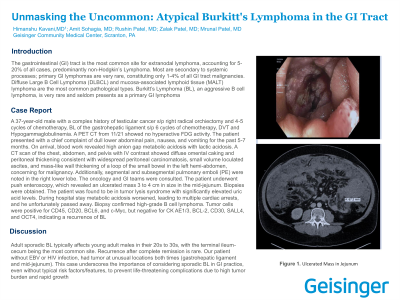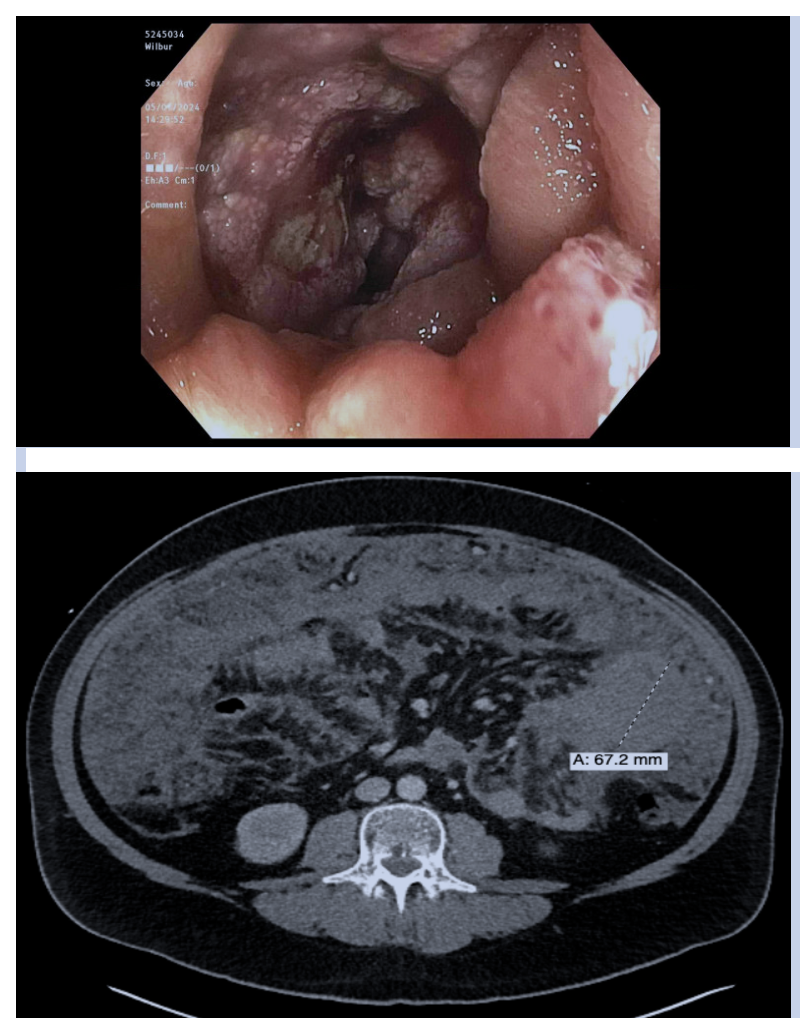Tuesday Poster Session
Category: Small Intestine
P4955 - Unmasking the Uncommon: Atypical Burkitt's Lymphoma of the Gastrointestinal Tract
Tuesday, October 29, 2024
10:30 AM - 4:00 PM ET
Location: Exhibit Hall E

Has Audio

Himanshu Kavani, MD
Geisinger Community Medical Center
Old Forge, PA
Presenting Author(s)
Himanshu Kavani, MD1, Amit Sohagia, MD2, Rushin Patel, MD3, Zalak Patel, MD4, Mrunal Patel, MD5
1Geisinger Community Medical Center, Old Forge, PA; 2Geisinger Community Medical Center, Scranton, PA; 3Dignity Health Community Hospital, San Bernardino, CA; 4University of California Riverside, Riverside, CA; 5Trumbull Regional Medical Center, Warren, OH
Introduction: The Gastrointestinal (GI) tract is the most common site for extranodal lymphoma, accounting for 5-20% of all cases, predominantly nonHodgkin’s Lymphoma. Most are secondary to systemic processes;primary GI lymphomas are very rare, constituting only 1-4% of all GI tract malignancies. Diffuse Large B Cell Lymphoma (DLBCL) and mucosa-associated lymphoid tissue (MALT) lymphoma are the most common pathological types. Burkitt’s Lymphoma (BL), an aggressive B cell lymphoma, is very rare and seldom presents as a primary GI lymphoma
Case Description/Methods: A 37-year-old male with a complex history of testicular cancer s/p right radical orchiectomy and 4-5 cycles of chemotherapy, BL of the gastrohepatic ligament s/p 6 cycles of chemotherapy with no hyperactivity on FDG-PET scan in 11/21, DVT and Hypogammaglobulinemia presented with chief complaints of dull lower abdominal pain, nausea, and vomiting since past 5-7 months. On arrival, blood work revealed high anion gap metabolic acidosis with lactic acidosis. A CT scan of the chest, abdomen, and pelvis with IV contrast showed diffuse omental caking and peritoneal thickening consistent with widespread peritoneal carcinomatosis, small volume loculated ascites, and mass-like wall thickening of a loop of the small bowel in the left hemi-abdomen, concerning for malignancy. Additionally, segmental and subsegmental pulmonary emboli (PE) were noted in the right lower lobe. The oncology and GI teams were consulted. Subsequently patient had push enteroscopy, which revealed an ulcerated mass 3-4 cm in size in the mid-jejunum. Biopsies were obtained. The patient was found to be in tumor lysis syndrome with significantly elevated uric acid levels. During hospital stay metabolic acidosis worsened, leading to multiple cardiac arrests, and he unfortunately passed away. Biopsy confirmed high-grade B cell lymphoma. Tumor cells were positive for CD45, CD20, BCL6, and c-Myc, but negative for CK AE1/3, BCL-2, CD30, SALL4, and OCT4, indicating a recurrence of BL
Discussion: Adult sporadic BL typically affects young adult males in their 20s to 30s, with the terminal ileum-cecum being the most common site. Recurrence after complete remission is rare. Our patient without EBV or HIV infection, had tumor at unusual locations both times (gastrohepatic ligament and mid-jejunum). This case underscores the importance of considering sporadic BL in GI practice, even without typical risk factors/features, to prevent life-threatening complications due to high tumor burden and rapid growth

Disclosures:
Himanshu Kavani, MD1, Amit Sohagia, MD2, Rushin Patel, MD3, Zalak Patel, MD4, Mrunal Patel, MD5. P4955 - Unmasking the Uncommon: Atypical Burkitt's Lymphoma of the Gastrointestinal Tract, ACG 2024 Annual Scientific Meeting Abstracts. Philadelphia, PA: American College of Gastroenterology.
1Geisinger Community Medical Center, Old Forge, PA; 2Geisinger Community Medical Center, Scranton, PA; 3Dignity Health Community Hospital, San Bernardino, CA; 4University of California Riverside, Riverside, CA; 5Trumbull Regional Medical Center, Warren, OH
Introduction: The Gastrointestinal (GI) tract is the most common site for extranodal lymphoma, accounting for 5-20% of all cases, predominantly nonHodgkin’s Lymphoma. Most are secondary to systemic processes;primary GI lymphomas are very rare, constituting only 1-4% of all GI tract malignancies. Diffuse Large B Cell Lymphoma (DLBCL) and mucosa-associated lymphoid tissue (MALT) lymphoma are the most common pathological types. Burkitt’s Lymphoma (BL), an aggressive B cell lymphoma, is very rare and seldom presents as a primary GI lymphoma
Case Description/Methods: A 37-year-old male with a complex history of testicular cancer s/p right radical orchiectomy and 4-5 cycles of chemotherapy, BL of the gastrohepatic ligament s/p 6 cycles of chemotherapy with no hyperactivity on FDG-PET scan in 11/21, DVT and Hypogammaglobulinemia presented with chief complaints of dull lower abdominal pain, nausea, and vomiting since past 5-7 months. On arrival, blood work revealed high anion gap metabolic acidosis with lactic acidosis. A CT scan of the chest, abdomen, and pelvis with IV contrast showed diffuse omental caking and peritoneal thickening consistent with widespread peritoneal carcinomatosis, small volume loculated ascites, and mass-like wall thickening of a loop of the small bowel in the left hemi-abdomen, concerning for malignancy. Additionally, segmental and subsegmental pulmonary emboli (PE) were noted in the right lower lobe. The oncology and GI teams were consulted. Subsequently patient had push enteroscopy, which revealed an ulcerated mass 3-4 cm in size in the mid-jejunum. Biopsies were obtained. The patient was found to be in tumor lysis syndrome with significantly elevated uric acid levels. During hospital stay metabolic acidosis worsened, leading to multiple cardiac arrests, and he unfortunately passed away. Biopsy confirmed high-grade B cell lymphoma. Tumor cells were positive for CD45, CD20, BCL6, and c-Myc, but negative for CK AE1/3, BCL-2, CD30, SALL4, and OCT4, indicating a recurrence of BL
Discussion: Adult sporadic BL typically affects young adult males in their 20s to 30s, with the terminal ileum-cecum being the most common site. Recurrence after complete remission is rare. Our patient without EBV or HIV infection, had tumor at unusual locations both times (gastrohepatic ligament and mid-jejunum). This case underscores the importance of considering sporadic BL in GI practice, even without typical risk factors/features, to prevent life-threatening complications due to high tumor burden and rapid growth

Figure: Ulcerated Mass in Jejunum
Disclosures:
Himanshu Kavani indicated no relevant financial relationships.
Amit Sohagia indicated no relevant financial relationships.
Rushin Patel indicated no relevant financial relationships.
Zalak Patel indicated no relevant financial relationships.
Mrunal Patel indicated no relevant financial relationships.
Himanshu Kavani, MD1, Amit Sohagia, MD2, Rushin Patel, MD3, Zalak Patel, MD4, Mrunal Patel, MD5. P4955 - Unmasking the Uncommon: Atypical Burkitt's Lymphoma of the Gastrointestinal Tract, ACG 2024 Annual Scientific Meeting Abstracts. Philadelphia, PA: American College of Gastroenterology.
